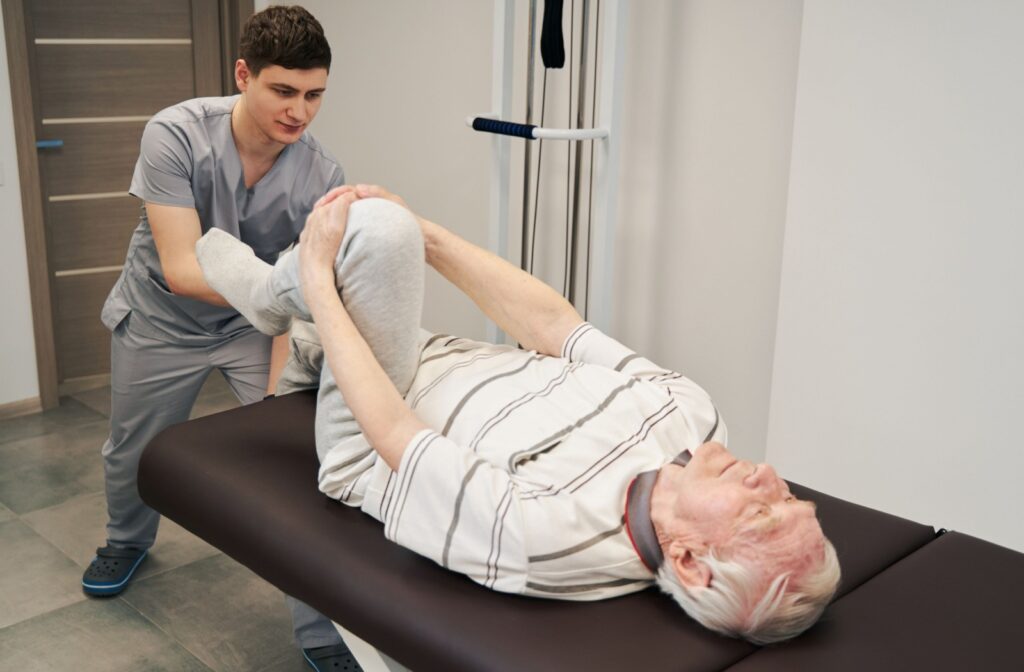Recovering from hip replacement surgery can feel overwhelming, especially when you’re wondering how quickly you’ll get back to doing the things you love. The good news is that hip replacement rehabilitation speeds up recovery by initiating movement within 24 hours of surgery, preventing complications through early mobility, and providing structured therapy that rebuilds strength and function in a safe and supportive environment.
Key Takeaways
- Hip replacement rehab typically begins within 24 hours after surgery
- Structured rehabilitation programs can reduce recovery time by weeks or months
- Professional rehab centers provide specialized equipment and round-the-clock support
- Most people see significant improvement within 2-6 weeks with proper rehabilitation
What Is Hip Replacement Rehab? Why Does It Matter?
Hip replacement rehabilitation isn’t just about getting you walking again—it’s a comprehensive approach to rebuilding your strength, mobility, and confidence after surgery. The process involves physical therapy, occupational therapy, and sometimes speech therapy if you experienced complications from anesthesia.
Your rehabilitation team will work with you to address pain management, teach you safe movement techniques, and help you regain the skills needed for daily living. This might include everything from getting dressed to climbing stairs safely.
Getting Started Within 24 Hours After Surgery
You might be surprised to learn that your rehabilitation journey begins almost immediately after your hip replacement surgery. Within the first day, a physical therapist will visit your hospital room to help you sit up, stand, and take your first steps with your new hip. These early movements might feel scary, but they’re essential for your recovery.
From Simple Movements to Daily Activities
Your rehab program progresses gradually from basic movements to more complex activities. You’ll start with simple exercises such as ankle pumps and gentle leg slides, while lying in bed.
As you grow stronger, you’ll work on walking with assistive devices, navigating stairs, and practicing everyday tasks such as getting dressed and using the bathroom safely.
How Does A Structured Rehab Program Accelerate Your Recovery?
When you participate in a structured rehabilitation program, you’re not just getting therapy—you’re getting a coordinated approach that addresses all aspects of your recovery. This comprehensive care can significantly reduce the time it takes to regain your independence.
Early Movement Prevents Complications
One of the most significant advantages of structured rehabilitation is its emphasis on early movement to prevent serious complications. Blood clots, pneumonia, and muscle weakness are real risks after surgery, but regular movement helps your body avoid these problems.
Your therapy team will guide you through safe exercises and activities that keep your blood flowing and your lungs clear. This proactive approach often results in fewer setbacks and a smoother overall recovery process.
Strengthening Muscles Around Your New Hip
Your hip replacement is only as strong as the muscles supporting it. Structured rehab programs focus heavily on rebuilding the strength in your hip, thigh, and gluteal muscles that may have weakened before and after surgery. Through targeted exercises and progressive resistance training, you’ll gradually rebuild the muscle strength needed to support your new joint.
Restoring Function for Everyday Tasks
Beyond building strength, rehabilitation helps you relearn how to perform daily activities safely with your new hip. Occupational therapists work with you on practical skills like getting in and out of cars, reaching for items, and managing household tasks.
This functional training is what transforms your recovery from simply having a new hip to truly living independently again. You’ll practice real-world scenarios in a safe environment before returning home.
Recovery Timelines & What Affects Your Progress
Understanding what to expect during your recovery can help you stay motivated and track your progress. While everyone heals at their own pace, there are general milestones that most people reach during hip replacement rehabilitation. Exercise plans for older adults can guide safe, effective movements that support your rehabilitation goals.
First Week: Hospital to Rehabilitation Center
Your first week after surgery is all about getting mobile and managing pain effectively. You’ll typically spend 1-3 days in the hospital before moving to a skilled rehabilitation center if you need additional support.
During this time, your primary goals are walking short distances with assistance, navigating stairs as needed, and learning how to care for yourself safely at home. Most people are surprised by how much they can accomplish in just a few days.
2-6 Weeks: Building Strength & Mobility

The next phase of your recovery focuses on building strength and increasing your walking distance. You’ll work intensively with physical and occupational therapists to improve your balance, coordination, and endurance. Many people see dramatic improvements during this period, progressing from using a walker to a cane, or from a cane to walking independently.
3-6 Months: Returning to Regular Activities
By three to six months post-surgery, most people can return to their regular activities with some modifications. You may start driving again, return to work, and participate in low-impact recreational activities.
How Can I Make the Right Choice for My Hip Replacement Recovery?
Choosing where to complete your hip replacement rehabilitation is one of the most important decisions you’ll make for your recovery. The right environment can help you heal more quickly, prevent complications, and regain your independence faster.
Why Professional Rehab Makes a Difference
Professional rehabilitation centers offer resources that simply aren’t available at home. From specialized equipment to round-the-clock medical support, these environments are designed specifically to aid individuals in recovering from major surgeries.
You’ll also benefit from being around other people who are going through similar experiences. This community aspect often provides motivation and encouragement that accelerates the healing process.
Setting Yourself Up for Long-Term Success
The goal of hip replacement rehabilitation isn’t just to get you walking again—it’s to help you return to living life on your own terms. Quality rehabilitation programs focus on long-term outcomes, not just short-term improvements.
At Woodbury Senior Living, we recognize that recovery encompasses more than just physical healing. Our comprehensive approach addresses your medical needs while supporting your overall well-being and independence. Contact us today to schedule a tour of our rehabilitation services and discover how we can support your recovery journey, helping you get back to doing what you love.



